|
May
2022
Contents
Monthly Meeting
Upcoming Field Trips
President's Message
Special Report
Bird of the Month
Field Trip Reports
MAY UCB MEETING:
Thursday, May 12th , 7pm
Bird collection tour of the Bean Museum: We're
resuming in person meetings and taking it back to the Monte L. Bean museum on
BYU campus this month! We'll start by gathering in the orientation room behind
the front desk (where we used to meet) to go over monthly announcements, and
then we'll get a behind-the-scenes look at the bird collection where they house
thousands of bird specimens from around the world. After our visit to the
collection room, we'll finish the meeting with a self-tour of the rest of the
museum. Visitor parking is available but may require a parking pass which you
can pick up upon arrival at the museum front desk.
FIELD TRIPS:
(Please bring walkie talkies set to 5-0)
May 6,
2022 (Friday)
UTAH COUNTY HOTSPOTS fieldtrip
Meet at 7 am at Payson Walmart in the parking lot to the west of the Quick
Quack Carwash.
We will do our route to prepare for the GSL bird festival fieldtrips. It is
a long day. Please bring a lunch.
May
20-21 2022
Grand and San Juan County
On Friday we will meet at the Swanny Ciy Park 400 N.100 W. Moab at 11 am.
Our first birding spot will be by the Kane Creek OHV parking lot. I usually see
a lot of birds here, hopefully we will get our 22 species for Grand County, if
not we will stop at the Scott S. Matheson Wetlands Preserve and around town.
Please bring snacks, a lunch and water.
Then we will head to Devil's Canyon Campground to set up camp. Or if you want
there are hotels in Monticello and Blanding. I would recommend getting
reservations ASAP.
After setting up camp we can look for birds around the campground.
Saturday we will meet at 8 or 9 am depending on the weather to look for birds
around the campground, drive to Recapture reservoir and if we have time go check
out the Blue mountains. I love this area and I am excited to share it with you
all. My favorite species down here are Acorn Woodpecker, Western Bluebird, Pygmy
Nuthatch, Grace's Warbler and hopefully Red Crossbill! I have also seen
Williamson's Sapsucker, Lewis's Woodpeckers and so many others!
Coming up next month
June 3-4 2022
Washington County
Friday we will meet at 6 am at the Bluff street McDonald's in St. George.
We will drive out to Lytle Ranch. We will spend a lot of time there. Please
bring a lunch and water. After that we will see if we have time to go to the
Gunlock area to look for Common Blackhawk, go to Snow Canyon and Tonaquint
Nature Park.
Saturday we will meet at the Hurricane Walmart at 7 am. From there we will go
straight up Kolob Terrace to Lava Point Lookout to look for California Condors.
We will walk around the area there looking for birds, then drive around to a few
other good spots.
If we have time we will check out Dalton Wash for Rufous-crowned Sparrows and
hit Grafton. Plan on lunch that day as well.
Remember to book your hotels ASAP.
On your drive down Thursday please stop in Iron County to get your 22 species.
My favorite spot is the trail along the river that goes up Cedar Canyon-Lower (aka
Canyon trail) its a ebird hotspot, i also like Canyon Park. I would think you
could find all 22 species in a few hours there.
President's Message -
April 2021
by Machelle Johnson
|
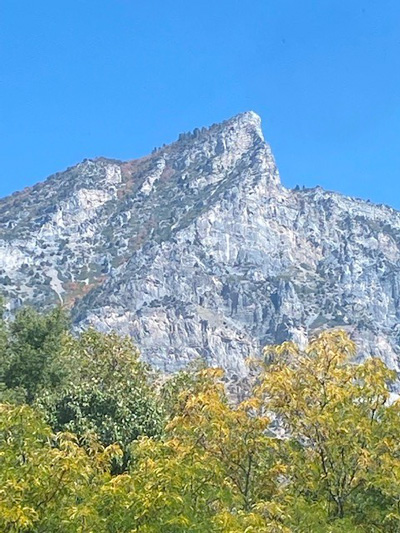
My office view of Squaw Peak
|
It was fun to see some of you on the April field trips,
and at Noah Strycker's presentation. I'm so glad we are able to meet in person
more now. I've talked to several of you who are doing great with the challenge,
getting out there to see the birds in so many counties. I'm loving all of the
Facebook posts as well. Spring is such a great time for birding in our state!
Out my office window I see a lot of birds this time of year. I watch Crows,
Turkey Vultures, Cedar Waxwings, Woodhouse's Scrub Jays, Robins and House
Finches. A nesting pair of Coopers Hawks patrol the area as well. My 'yard' list
at work is up to 31, I saw 3 Sandhill Cranes fly over about a month ago, and a
Bald Eagle flew by in January. I've had House Sparrows, House Finches and a
Black-chinned Hummer sit on the window ledge or hover near the window to admire
themselves in the reflection. I'm glad I have the opportunity to see out windows
even when I'm stuck at my desk all day!
In other news, I saw this article pop up on my Facebook page and thought it was
really neat. Nature is astounding and lovely and fierce and gentle all at once.
I love living in Utah, near the mountains and the lake. I love the 4 changing
seasons we experience, and being able to enjoy so much of it on a daily basis. I
love the friendship and fellowship of the birding community and meeting such
great people along the way.
I think this article caught my eye because I'm getting excited to start planting
in my garden and flower beds. I hope you enjoy these cool flowers, and I hope to
see you all in May, we've got some fun field trips planned and we'll meet at the
Bean Museum for our May meeting!
Flowers that look like birds,
Unique Resemblance: 10 Flowers That Look Like Birds - EarthWonders.co
Machelle
,__,
(0,0)
/)_)
|
|
|
|
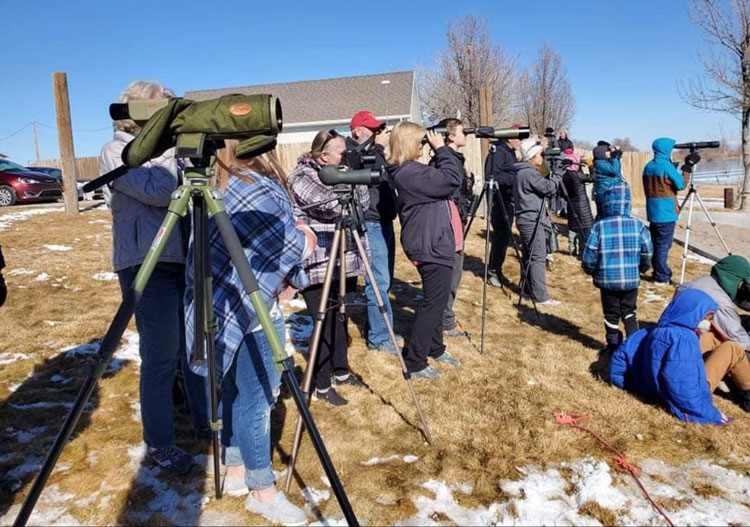 |
|
|
|
Sneaking in Some Lifers in Texas
by Keeli Marvel
Work sent me down to San
Antonio last month for a recertification course for a pesticide applicator and
program manager certification I have to maintain as the Pest Management
Coordinator on my installation. As with most trips I go on, I checked eBird a
few weeks before my trip to see if there were any species I had not seen yet
that were possible to get while I was down there. Barred Owl was top on my list
and has been a nemesis bird for awhile. I've tried a few times, but as you all
know, owls are sometimes hard to track down, unless you happen to know where
they are nesting. I did some sleuthing and found a few ebird records of an owl
being reported pretty consistently at a particular location. So, the first
day I flew into San Antonio, I picked up my rental car, dropped my stuff off at
my hotel, and set out on a bird hunt. My search took me to a really cool network
of trails on the northwest end of San Antonio called the Howard S. Peak Greenway
Trails System.
The trails connect a series of parks and access
points, and it was at one of these along the Leon
Creek Greenway that I found a pond where I tracked down my lifer Barred Owl.
I wandered around the pond checking all the trees until I spotted one that
looked right sized to house a cavity nesting owl, and as I glassed the tree I
could just barely see an owl face peeking out at me from a crack in the trunk. I
whispered a triumphant yessssss to myself, snapped a couple quick digiscoped
photo through my binos, sent off a celebratory text or two, and continued my
circuit around the pond. Other cool birds I spotted around the pond included
Black-crested Titmouse, Carolina Wren, Black-and-white Warblers (one of my
favorites), White-winged Doves, and plenty of Northern Cardinals.
After being stuck in training all week, and taking (and passing) my
recertification exams, I was ready to hit the road again when they released us
on Friday. I packed up my stuff and hit the road for the coast. After a quick
stop to photograph Scissor-tailed Flycatchers on the drive down, and a
bbq lunch in Corpus Christie, I headed out to Mustang Island State Park where I
went for a walk down the beach. Along the beach there I spotted five different
species of terns, most of them all in one mixed flock on the beach - Least,
Caspian, Forster's, Royal, and Sandwich. I also saw what felt like a
million Sanderlings, laughed at (and with) some Laughing Gulls,
and got up close and personal with a Snowy Egret who I much enjoyed
watching hunt for crustaceans and fish in pools along one of the jetties.
|
|
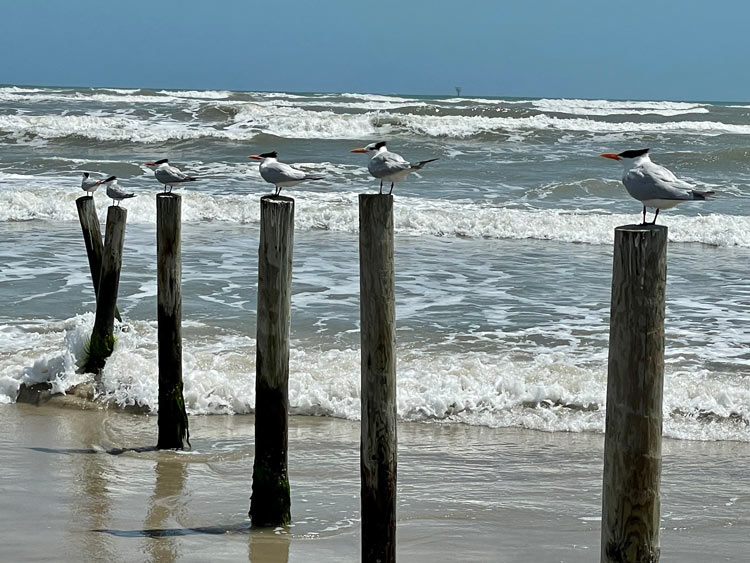
|
|
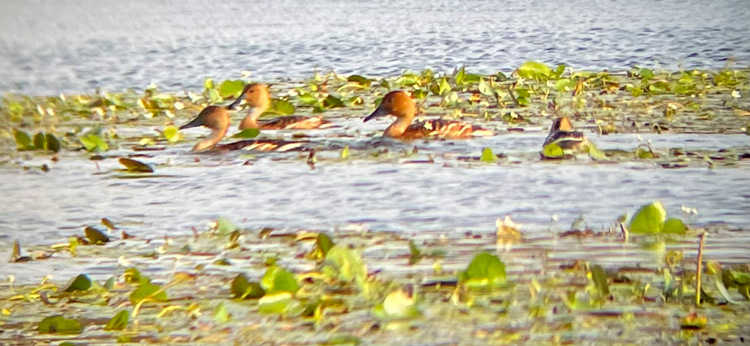
|
|
From there, I drove up to Port Aransas, hopped the ferry to
Aransas Pass where I dropped my luggage off at a little airbnb, and headed to
Ingleside Live Oak Park where I got my second lifer of the trip: Fulvous
Whistling Ducks! I'd seen them reported on eBird at a pond at Live Oak Park,
and sure enough, I parked, walked to the pond, and there they were! Talking to
some local birders the next day, I guess they move through the area in the
spring and I'd just gotten lucky on my timing and was able to see them. |
|
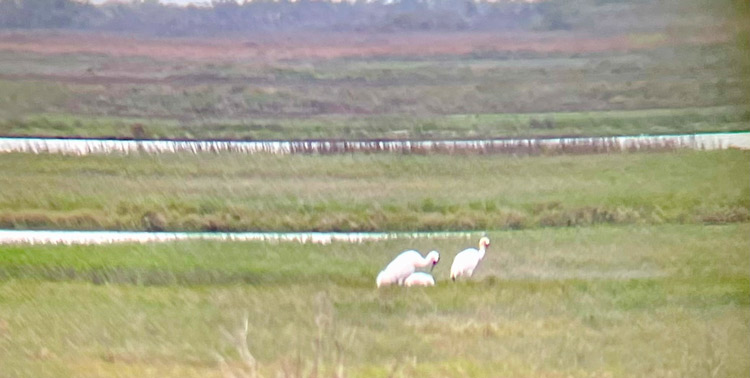
|
|
My last lifer of the trip was not a guarantee, and in fact,
earlier in the week I'd been convinced it might not happen. Whooping crane
populations were very nearly wiped out by habitat loss and overhunting, and back
in the 1940s there were only 15 left in the wild. With the help of
conservationists, captive breeding programs, and some creative strategies, their
population is slowly recovering, so it was a real treat to get to try and see
them. I've never seen Whooping Cranes before, and Bryan and Suzi had both
suggested to me I book one of the boat tours that goes up into Aransas NWR to
see them. So, with a couple days left before my trip, I booked a boat tour out
of Rockport with Rockport Birding and Kayak Adventures and Captain Tommy and
crossed my fingers. During the week of my training the captain had emailed us
and said most of the cranes had left to head north, and it wasn't a guarantee
that we would see them, so I was trying not to get my hopes up.
The morning of the boat tour was overcast and I boarded a
small boat appropriately called the Skimmer with about 20 other people. We
cruised across Aransas Bay and up into the refuge, and saw sever fun species
like American Oystercatchers, Dunlin, Long-billed Dowitcher, and Ruddy
Turnstone, and as we pulled up into one of the waterways inside the refuge -
we were in luck! The captain spotted a Whooping Crane foraging along the
edge of the marsh for the Blue Crabs that make up their primary diet there. A
little further up into the refuge we got even luckier and saw a family of three
Whooping Cranes way off in the marsh. Success! Lifer #3! After that, the
rest of the boat trip was icing on the cake. We cruised further north to some
little island rookeries where hundreds of birds were nesting/roosting and saw
bunches of Roseate Spoonbills (always a treat and one of my favorite
birds), Reddish Egrets, Great Egrets, Snowy Egrets, Great Blue Herons,
terns, and a few other species. On the ride back to Rockport we had another
treat - a pod of Atlantic Bottle-nosed Dolphins showed up to follow our boat and
play in our wake for awhile. It was a real treat to go out on a boat trip with a
captain who was very knowledgeable about the local bird species. Following my
boat tour, I drove straight back to San Antonio and headed to the airport for my
flight home thankful for a successful trip and the opportunity to add a few more
species to my life list.
Happy Birding!
Keeli Marvel
|
|
|
BIRD OF THE MONTH:
|
|
|
|
|
Bicknell's Thrush
(Catharus
bicknelli)
[BITH]
Compiled by
Robert Parsons
This month, I wanted to write about a
bird that I have never seen---but that was still found in the ABA area. For
years I have looked for Bicknell’s Thrush and despite several attempts to find
one, never have. So, I selected that species for our monthly report.
|
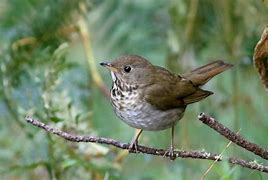
Photo from Bing.com |
Like our other spotted North American thrushes, this bird is mostly found on the
ground or perched in low branches or bushes. Nearly identical, although
slightly smaller, to Gray-cheeked Thrush, it is a medium-sized thrush, weighing
about the same as a first-class letter. It is mostly warm brown on the back,
with heavy dots on a breast washed with buffy tones and a prominent pale buffy
strip on the underwing. The tail is dull chestnut. The flight pattern is
relatively swift and direct, with somewhat jerky wing strokes. Difficult to
tell apart from the Gray-cheeked Thrush, the best clues are breeding range and
song (the Bicknell’s has a higher pitched song, with an ascending end, compared
to descending on the Gray-checked). The Bicknell’s lower mandible also has much
more yellow than the Gray-cheeked and until 1995 it was considered a
subspecies.
Except for the Hermit Thrush, spotted thrushes in North America are usually
found east of the Mississippi River. The Bicknell’s Thrush is no exception,
with a very limited breeding range in the far montane areas of northern New
England and parts of Eastern Canada---primarily above 3,000 feet in the
mountains of northern New York, Vermont, Maine and Eastern Canada (it can be
locally common in these areas). The wintering range is mostly in wet montane
forests in Hispaniola (West Indies) and it may also winter in Cuba and Jamaica,
although more research is needed.
This bird was named after Eugene Bicknell, an American amateur ornithologist
(see there is hope for all of us), who discovered the species on Slide Mountain
in the Catskills in the late 19th Century. One interesting note---a
group of thrushes are collectively known as a “hermitage” or a “mutation” of
thrushes. No idea where that came from!
Bicknell’s Thrush, a member of the Catharus genus, eats insects, especially ants
and beetles, along with snails, moths, slugs, spiders, earthworms and even small
salamanders, supplemented by some berries and fruit in the fall. They forage on
the ground, scratching with their feet to uncover prey or patiently watching and
listening, much as American Robins do. When feeding young, they will even
occasionally be seen flycatching or hover-gleaning.
Since the Bicknell’s Thrush was only recently recognized as a full species, no
long-term population trends are available. However, Canadian surveys have
shown steep declines in populations since the 1960s and Bicknell’s Thrush have
disappeared from numerous historic breeding sites. Although the reasons for
declining populations are not well understood, they may include airborne
pollutants that harm the high-elevation forest habitats and contribute to higher
levels of mercury. Warming temperatures may also be a factor. The Bicknell’s
Thrush has an estimated population of 60,000-120,000. The limited breeding
habitat and habitat destruction in its wintering range, have raised conservation
concerns, giving this thrush a Vulnerable status
Females apparently select the nest site and build the nest, usually near the
trunk of a tree in dense stands of short or stunted balsam fir and often near a
gap or edge in the forest. Nests are about five feet off the ground and made of
fir or spruce twigs, with some grass or horsehair used to line the nest, which
is about five inches across. Clutch size is 3-4 bluish green eggs with light
brown speckling, with a 9-14 day incubation period followed by another 10-12 day
nestling period.
|
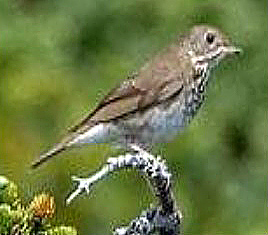
Photo from Bing.com |
Bicknell’s Thrush have a very unique mating and breeding system, in that there
are not traditional pair bonds between males and females. This behavior is
unique among North American songbirds, with the possible exception of Smith’s
Longspur. Both males and females mate with multiple partners and most broods
contain young from several fathers. Males often feed nestlings in two nests at
once (feeding nestlings that are not their own) and often more than one will
feed young in any particular nest. Males do not appear to defend classic
territories but rather sing from a large home range that overlap with multiple
active nests. Males sometimes chase other males, but not to the extent that
other territorial male songbirds do. Females, however, regularly chase away
other females from their smaller home range, which is centered around the nest
area. Occasionally, males will pursue females in flight, sometimes singing, and
drooping or fluttering their wings when perched or singing quietly, presumably
as prelude to copulation.
I still hope to find one of these beautiful, but somewhat elusive birds on a
hike up the mountains of New England. Want to come with me?
References, Notes and Credits
-
Sibley
Birding App.
-
“Birds of the West Indies,” Herbert
Raffaele.
-
“The Stokes Field Guide to the Birds of North America,” Donald
and Lillian Stokes.
-
“National Geographic Field Guide to the Birds of North America,” Seventh
Edition. Jon L. Dunn.
-
iBird
Pro Birding App.
-
Peterson Birding Field Guide App.
-
Wikipedia, “Bicknell’s Thrush”
-
All
About Birds (allaboutbirds.org).
-
“Where to Watch Birds in Ceneral America, Mexico and the Caribbean,” Nigel
Wheatley and David Brewer.
[See
past Bird of the Month articles]
|
|
Field Trip Reports
|
Box Elder, Cache
& Weber County Fieldtrip
23 Apr 2022
by Suzi Holt
|
|
What a trip!!!
Alarm clock at 2:00 am, 403 miles, a tank and a half of gas, 17 birders, 71
species of birds in 3 counties, and we finished 3 more counties with 22
species for the 2022 challenge.
|
|
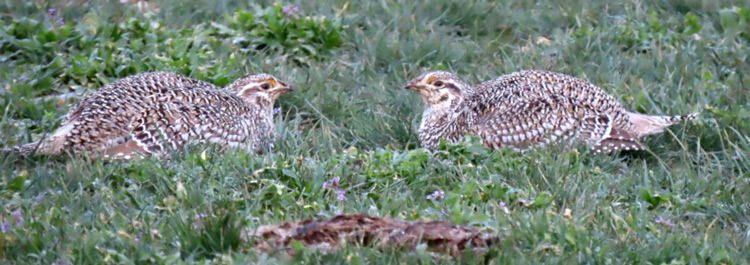
Sharp-tailed Grouse-Box Elder
|
|
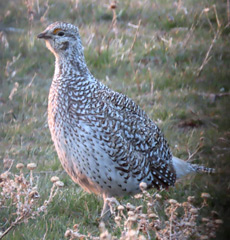
Sharp-tailed Grouse - Box Elder
photo by Amanda |
We headed out of Utah County around 3 am. and headed for Box Elder county,
the smart ones decided to get a hotel! Others were not so smart. Best bird
of the day Sharp-tailed Grouse!!! What a treat to hear and to watch
the "wind up baby toy" as Billy Fenimore would say. A priceless memory I
will never forget! Today we saw 16 birds dance their little hearts out! Box Elder County was amazing, we also saw
American Kestrel, Red-tailed Hawks, Black-billed Magpies, "28"
Swainson's Hawks and a Short-eared Owl! We also had tons of
Horned Larks, Common Ravens, American Robin, Mallards, Northern Flicker,
Western Meadowlarks, Northern Harrier's, Franklin Gulls, European Starlings,
and Rock Pigeons.
|
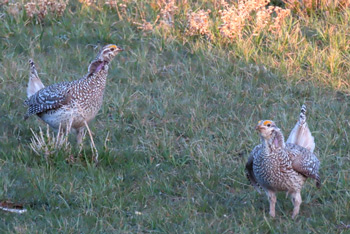
Sharp-tailed Grouse-Box Elder |
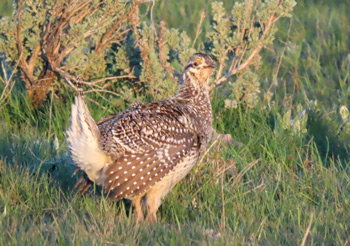
Sharp-tailed Grouse-Box Elder |
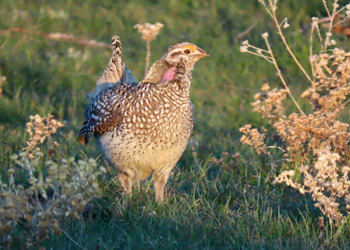
Sharp-tailed Grouse-Box Elder |
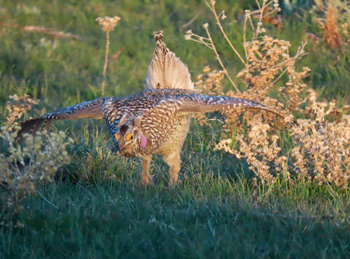
Sharp-tailed Grouse-Box Elder
|
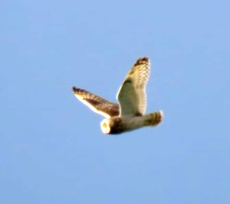
Short-eared Owl-Pocatello Valley |
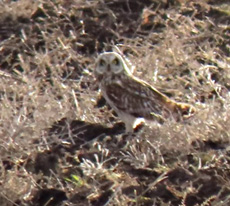
Short-eared Owl-Pocatello Valley
photo by Jessie |
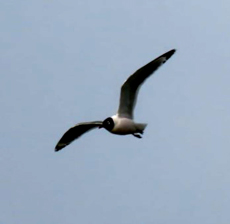
Franklin's Gull-Pocatello Valley
photo by Jessie |
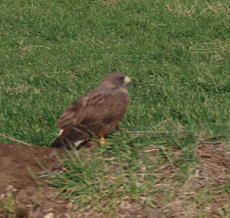 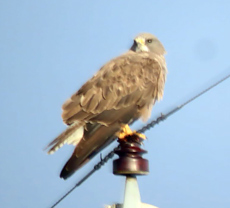
Swainson's Hawk-Pocatello
Valley Swainson's Hawk-Pocatello
Valley
photo by Jessie |
|
In
White's Valley we saw Mallards, Rock Pigeons, Red-winged and
Brewer's Blackbirds, lots of Loggerhead Shrikes with one vole
impalement!! We also saw Vesper and White-crowned Sparrows,
Mourning Doves, Killdeer, Black-billed Magpie, Red-tailed Hawks, a Golden
Eagle and Gray Partridge. It's always a treat to see the Gray
Partridges!
|
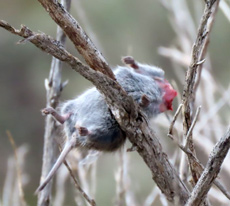
Shrike impalement-White's Valley
photo by Jessie |
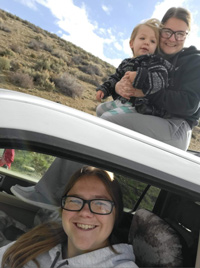
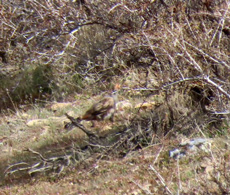
Gray Partridge- White's Valley
photo by Jessie |
|
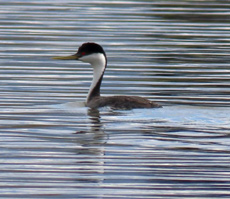
Western Grebe
Cutler Marsh Cache County |
Next stop Cache County and Cutler Marsh. It began to snow/sleet as
soon as we got there...but it quickly dissipated and we were able to quickly
find more than our 22 species. We saw Red-winged and Brewer's
Blackbirds, Canada Geese, Sandhill Cranes, Pied-billed Grebes, Western and
Clark's Grebes, Mallard, Gadwall, American Avocet, Franklin's Gull,
California Gulls, Double-crested Cormorant, American White-Pelican, Great
Blue and Black-crowned Night Herons, Northern Harrier, Bald
Eagle, Swainson's and Red-tailed Hawk, Common Raven, House Finch,
American Robin, Song Sparrow, Cliff Swallow and heard a Marsh Wren.
|
|
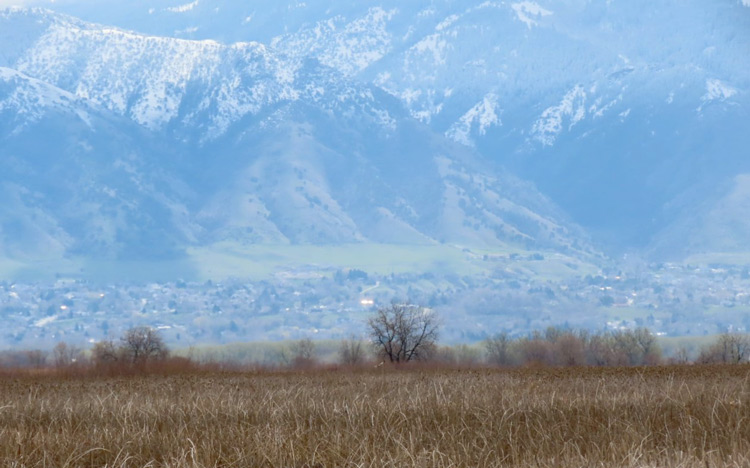
Cutler Marsh Cache County |
|
We
decided to check out the First Dam just for fun and we saw lots of
Barrow's and one Common Goldeneye, Mallards, Bald Eagle, Gadwall,
Greater Scaup, American Crow, House Finch, Pine Siskin, Lesser Goldfinch,
Ruby-crowned Kinglets and heard a Broad-tailed Hummingbird! |
|

Barrow's
Goldeneye-First Dam Cache County
|
|
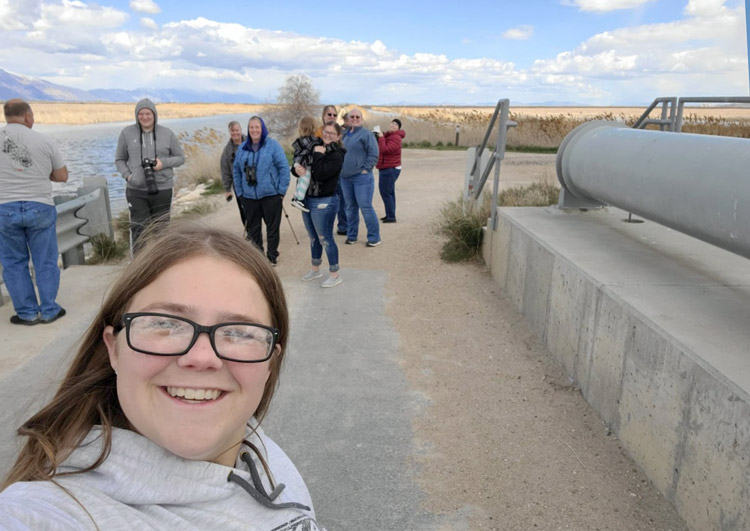
Ogden Bay WMA |
|
Next stop Ogden Bay WMA North Parking
Lot.
A great stop with Northern Shoveler, Mallard, American Coot, Red-tailed
Hawk, American Robin, Red-winged and Brewer's Blackbird, Canada
Goose, Northern Harrier, Green-winged and Cinnamon Teal, Canvasback,
Red-breasted Merganser, Gadwall, Caspian Tern, Forester's Tern. We also
saw Eared, Clark's and Pied-billed Grebes, Eurasian Collared Dove,
European Starling, Sandhill Crane, Black-necked Stilt, American Avocet,
American White Pelican, Killdeer, California Gull, Double-crested Cormorant,
Great Blue Heron, Great Egret, Snowy Egret, White-faced Ibis, Tree, Barn
and Bank Swallows, House Sparrow, some unidentified peeps and a
Solitary Sandpiper!
|
|
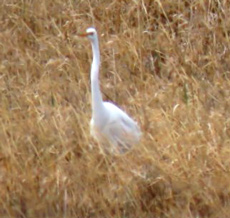 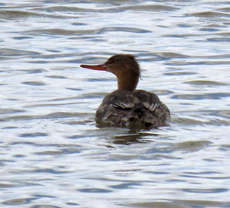 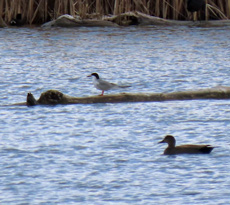 |
Great Egret- Ogden Bay
Red-breasted Merganser
Forester's Tern-Ogden Bay WMA Weber County
|
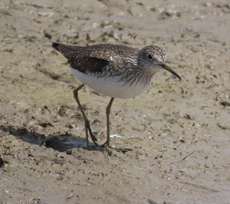 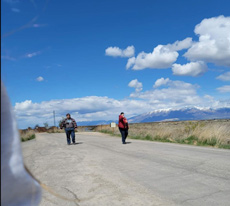 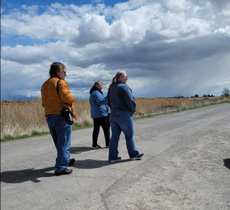 |
|
Solitary Sandpiper
Ogden Bay WMA Weber County |
I
think everyone had a great day, a few got new lifers and we all headed home
happy and exhausted!! Thanks to all who got up early, that sunrise was
totally worth it! And it wouldn't have been the same without you!
|
|
Tooele County Fieldtrip
16 Apr 2022
by Suzi Holt
|
|
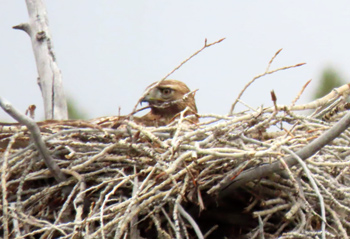
Red-tailed Hawk |
We had a great afternoon
fieldtrip today out in Tooele County. Our first destination was Clover
Springs Campground. As we got closer we saw a nesting Red-tailed Hawk.
As we entered the campground at Clover Springs it was so cold, the wind was
blowing and cold rain was starting to fall. We saw a couple Common Ravens
but decided we may have better luck finding our 22 species down in town. So
we lined up to head out. Luckily we had given Alona, Kathleen and Lynn a
radio. As we were leaving the campground they messaged us saying we think we
have a Pygmy Owl!! So yes we carefully turned around, and sure enough it was
a Northern Pygmy Owl! We all got good looks through the scope and
watched it for about 20 minutes. We thought if we stayed for 22 minutes we
could make our own new challenge rule and consider Tooele County done!
|
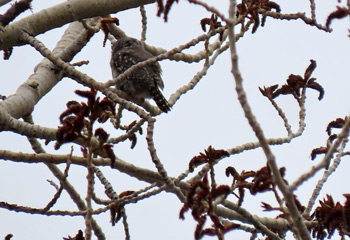
Northern Pygmy-Owl
|
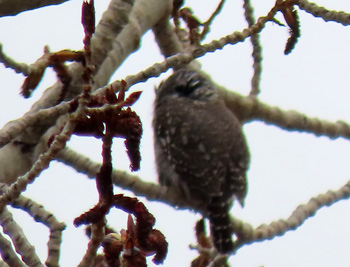
Northern Pygmy-Owl
|
|
But we decided to continue onward. On our way back to town we saw another
Red-tailed Hawk, Western Meadowlarks, a American Kestrel
and a few Turkey Vultures. We took a side road and found more
Turkey Vultures, European Starlings, Red-winged Blackbirds, American Robin,
Eurasion-collard Dove and a Ring-necked Pheasant.
|
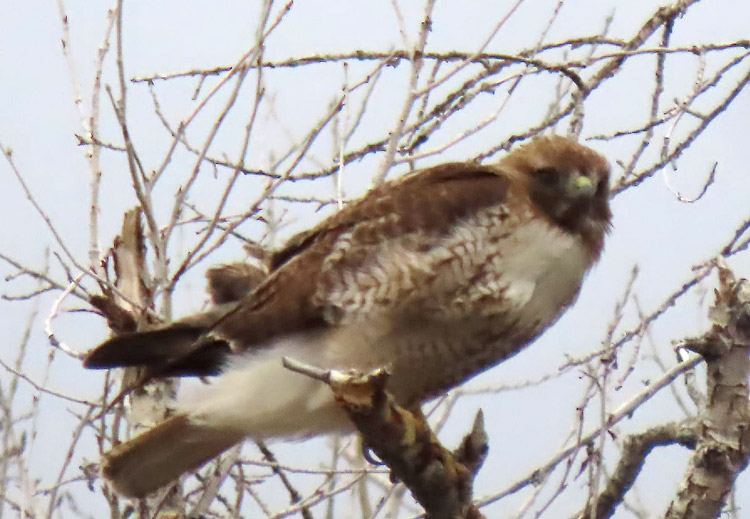
Red-tailed Hawk |
|
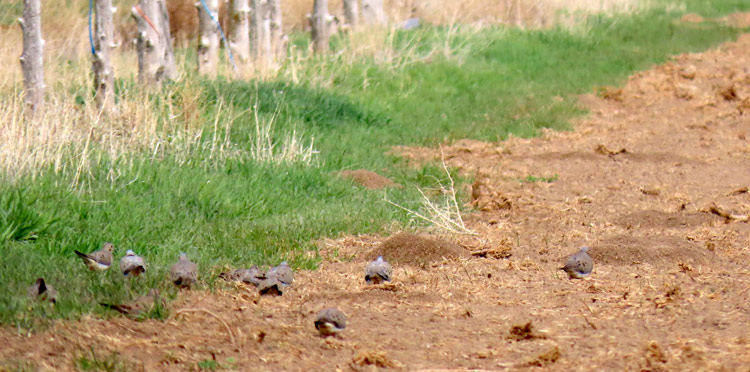
Mourning Doves
|
We then drove down Main Street in Rush Valley. We found
Mourning Doves, White-crowned Sparrows, House Sparrows and a
Vesper Sparrow. This was a great place to stop we also saw Sandhill
Cranes, a couple Say's Phoebes, a Western Kingbird,
Black-billed Magpie, Brewer's Blackbirds and a Killdeer. We then
stopped by the water ski reservoir. There were a few Swainson's Hawks,
Canada Geese, a American Coot, a Mallard, two Savannah
Sparrows and a Loggerhead Shrike!
|
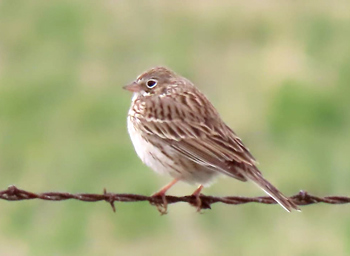
Vesper Sparrow
|
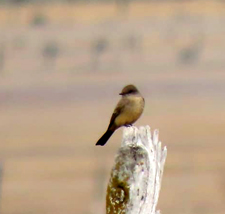
Say's Phoebe |
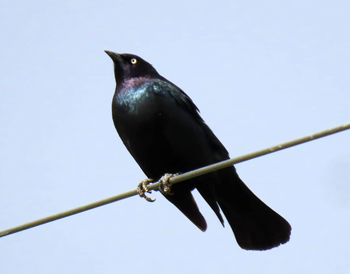
Brewer's Blackbird
|
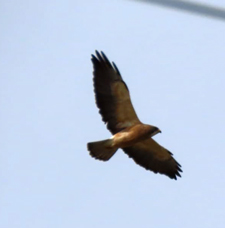
Swainson's Hawk |
|

Long-billed Curlews |
Our next stop was Fitzgerald WMA. In the
parking lot we found White-crowned Sparrows and a surprise
Lincoln's Sparrow. We had lots of American Coots, Canvasback, Ruddy
Duck, Redhead, Eared Grebes and the Swainson's Hawks put on a
great show. We also saw Osprey, Clark's Grebe, Double-crested Cormorants,
Yellow-headed Blackbird, Red-winged Blackbirds, Hooded Merganser, Common
Merganser, Northern Harrier's and had five Long-billed Curlews
fly over! There were Violet-green Swallows, and Canada Geese
too.
|
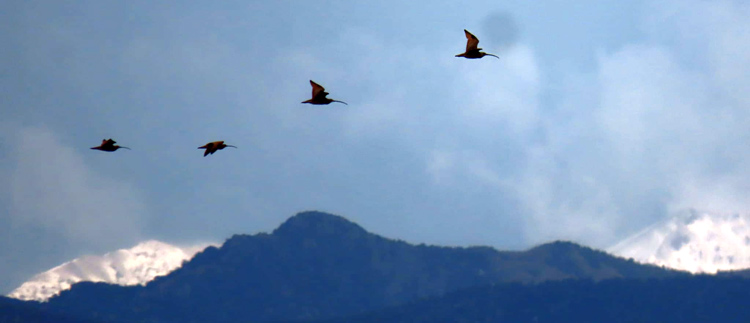 |
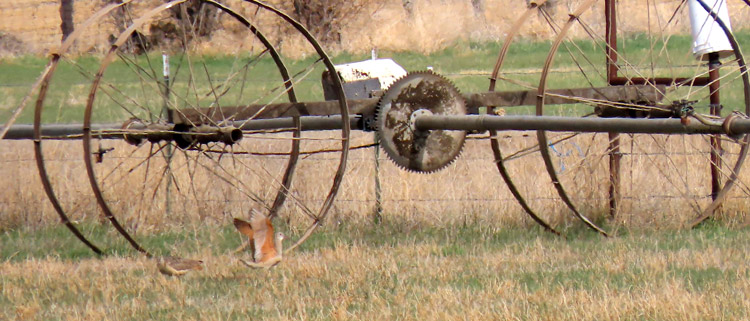
Long-billed Curlews
|
|
It was a great afternoon trip and we were
so grateful the weather finally cooperated. We also had a few new birders
join us as well. Thanks for coming!
|
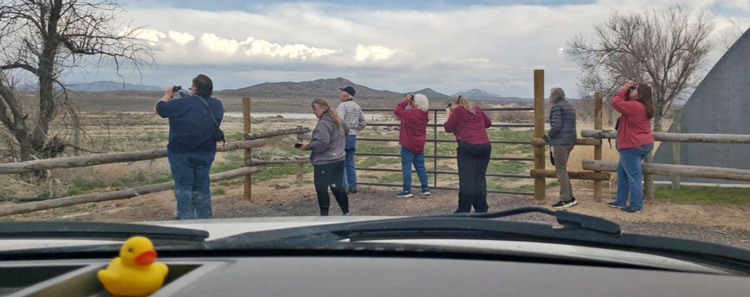
Birders in Tooele County -- they missed an exotic duck! |
|
|
|
|
|
Utah County Birders website
Utah County Birders Board Members
If you'd like to write an
article for the news newsletter...
send it to:
ucbirders@utahbirds.org
|
|
|
|
|